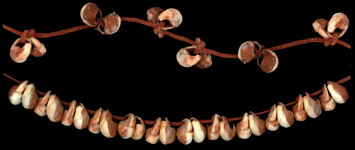In Style in the Stone Age
July/August 2013
 Even Paleolithic people knew that while fashions fade, style is eternal. A team led by University of Bordeaux archaeologist Marian Vanhaeren found that beaded necklace patterns changed in a relatively short time around 75,000 years ago, possibly within a few generations.
Even Paleolithic people knew that while fashions fade, style is eternal. A team led by University of Bordeaux archaeologist Marian Vanhaeren found that beaded necklace patterns changed in a relatively short time around 75,000 years ago, possibly within a few generations.
Vanhaeren and her colleagues analyzed shell beads from Blombos Cave, South Africa. Beads from two separate layers displayed patterns of wear distinct from one another, which suggested that they had been strung and worn differently at different times. The archaeologists made some beads of their own and strung them in a variety of styles. They then subjected them to use, and exposed them to a water-and-vinegar solution meant to mimic human sweat and accentuate the marks that came from everyday wear. “Voilà,” says Vanhaeren, “we had the wear patterns.” From the experiment, she concluded that in the older layers, shells hung freely on a string (above), while in the upper layers the shells were knotted together in a more complex pattern (top). Vanhaeren notes that the beads in both layers probably came from numerous necklaces. “All the people respected the rules and wore the beads in these specific patterns,” she says. In other words, the Blombos Cave people were slaves to fashion.